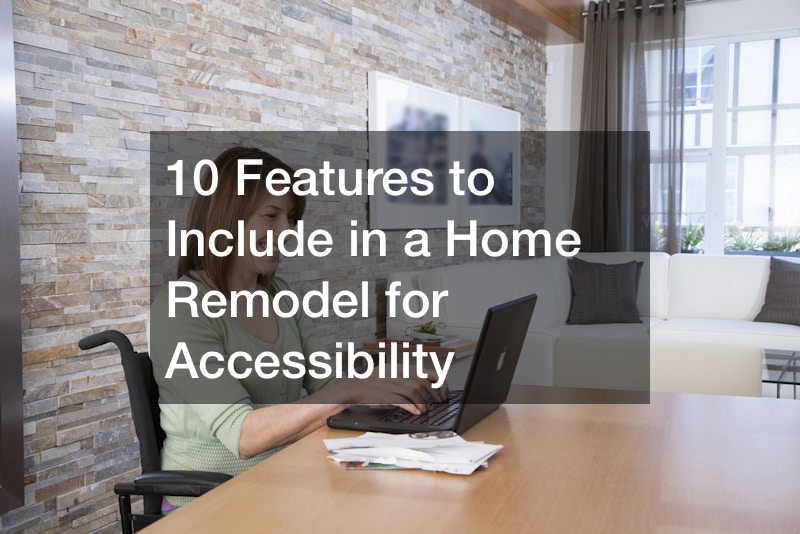
10 Features to Include in a Home Remodel for Accessibility
When you are remodeling your house for accessibility, you should know what features are needed. Once you determine what your house needs, you can contact a professional to make those changes. These features are the top ten to consider when doing a home remodel for accessibility.
1. Make Entrances Wheelchair Accessible
When you are considering a home remodel for accessibility, you may want to start with making it wheelchair accessible. A home renovation contractor can walk through your house with you to determine where you need modifications. When doing this, you should keep in mind who uses the space, their capabilities, and their needs. You want to consider the entryways, which include all of the doors and garage.
A wheelchair needs a ramp and hallways that are big enough to fit. You want to ensure the bathroom doorway is large enough for the wheelchair. You want to get in and out of the shower easily. Accessible bathrooms allow a wheelchair to fit under the sink. For your floor to be accessible, you want to pay attention to the steps and thresholds. Carpeting is hard for a wheelchair to navigate. Laminate plank flooring or vinyl is wheelchair-friendly flooring. It would be best if you focused on making the home more comfortable and functional.
2. Install a Stair Lift
If you have a second floor in your home, you should consider a stair lift installation as part of your home remodel for accessibility. Stairs are often challenging for individuals with disabilities. A chair lift makes your home more accessible. For those with limited mobility, stairs can be dangerous. They pose a risk of falling. A stair lift can reduce that risk and allow individuals to move freely throughout their homes.
Stair lifts are motorized seating devices that help an individual move up and down stairs. A motorized chair is combined with a custom railing system or track to move safely and quietly along the stairs. A rail or track option attaches to the stairs. It allows a seat to move along the stairs. There are typically two types of tracks. A straight track is intended for traditional staircases and curved for tracks for staircases that turn. In addition, some tracks have a folding rail which reduces trip hazards.
Some stair lift seats are fixed. This can sometimes be more difficult to use. If you opt for a stair lift with a swivel seat, it allows for easy entry. The chassis is the part that makes the stair lift move. It is attached to the rail. It has the main electronics like the motor, gears, and battery. The combination of all the pieces determines the quality and comfort of the ride. You can create different configurations and features that match best with your home.

3. Widen Interior Doorways
When you are thinking about a home remodel for accessibility, you may need to widen some of your doorways. You may want to consult with an interior remodeling contractor. They can help you determine which walls are safe to remove. If you have any unnecessary walls in your home, you could remove them. This would help to create more open, easily accessible spaces. You may want to remove a wall between the kitchen, dining room, living room, and home office.
Whichever walls make it easy for a wheelchair to get around are the ones you should consider removing. It’s important that you don’t remove any load-bearing walls. You also want to remove walls safely and properly so you don’t cause structural problems. Finally, you should consider making your doorways a minimum of 36 inches wide to make them accessible. You may have to widen your doorways to accommodate a wheelchair.
4. Install Grab Bars in the Bathrooms
When you are considering a home remodel for accessibility, don’t forget the grab bars for the bathroom. Grab bars are perfect for bathroom remodeling because they offer support and stability in the bathroom. In addition, they are helpful for those with mobility issues, including balance concerns or limited range of motion. All grab bars should be able to support at least 250 lbs. of weight.
Grab bars need to be sturdy. They must be installed into the studs with additional wood support in the walls. If you have a fiberglass shower, the installation may not be secure. There tend to be large gaps of space between the unit’s wall studs and the wall of your bathroom. You should contact a reputable contractor if you have a fiberglass shower. They can find and drill into the studs so the structure isn’t damaged.
Bathrooms tend to have many safety hazards for people with disabilities. The tile is often wet, and the surfaces are hard and unforgiving surfaces when people fall. Handrails and grab bars aren’t only for the bathroom. They are a great addition to other parts of your home as well.

5. Add Motion-Sensor Lighting Throughout Your Home
You should consider adding motion sensor lighting throughout your house as part of a home remodel for accessibility. Many people don’t think about the lighting in their house until it becomes a challenge. When you are remodeling, you should consider lighting. Adding more lighting is a simple home improvement feature that can be a lot of help.
LED lights are bright and help you see more clearly. They can assist you or a loved one while they navigate the house. They also last longer and use less electricity. You can add lighting along hallways, around door locks, and railings. You want to make sure none of the light casts shadows along corridors or in the moving spaces of rooms.
You want to ensure that your lights are motion sensors throughout the house. You won’t have to worry about first finding the light switch in the dark. If you aren’t able to turn on the light before you enter the room, motion sensor lighting is a great idea. You may need to lower the light switches so they are accessible from a seated position.
6. Install a Curbless Shower With a Bench
When you are investing in a home remodel for accessibility, consider adding a curbless shower to your bathroom. A curbless shower has a seamless flow. It is seamless and doesn’t have a curb or a threshold. This means that you can get in and out easily. It’s similar to a walk-in shower in that there isn’t a divider between the bathroom and the shower floor.
Curbless showers provide the advantage of accessibility for people with limited mobility. The floor is not raised, which means you have a level floor. This makes it accessible for wheelchairs. A remodeling contractor will explain that you can add grab bars, handheld showerheads, and other safety features.
Curbless showers have fewer places where mildew and grime can build up. This means the cleaning is easy and not as time consuming. This type of shower typically has ceramic floor tiles. These tiles are often resistant to mildew and bacteria. It’s important that these showers are designed and installed properly. If they are, then water isn’t a problem. One thing to remember with curbless showers is that they often don’t have doors. This makes it easier to spill and splash water out of the shower. Also, you must pay attention to the possibility of slipping and clogging the shower.

7. Install a Voice-Activated Smart Home System
When there isn’t enough light in your house, it can be dangerous for anyone, but especially someone with a disability. This makes electrical remodeling an important part of a home remodel for accessibility. You want to have strong and bright lights. You also want to make sure they are easy to access. You can change the location of the switch so they are lower and more accessible. You can also put the switch on the outside of the room. You can turn on the light before you actually walk into the room. Another option is to install lights that respond to voice-activated commands.
A voice-activated system makes it easy to control lights, thermostats, and appliances. They are especially easy for those with dexterity concerns. This type of system is usually built directly into fixtures and light bulbs. You can also have it built into your home with a whole house system. If you opt for standalone products, they may be able to work together. There are benefits and negatives to both options. It may come down to the budget you have available.
8. Install Kitchen Cabinets With Pull-Out Drawers
When facing a home remodel for accessibility, you should consider adding pull-out drawers to your kitchen cabinets. This simple change can help make your kitchen accessible to everyone. While this may be considered a luxury home remodeling project, it also helps everyone feel welcome in the kitchen. In addition, adding cabinets with pull-out drawers makes it easier to find cookware. A pull-out drawer is as simple as it sounds. It’s a drawer or cabinet with a pull on its front. You pull on the handle, and the drawer opens.
Pull-out drawers make the best use of all the space available. It is great for larger items like pots and pans. Pull-outs drawers are deeper drawers and are great options for items you’d like to stack. This could be dinner plates or dish towels. The drawers’ sides provide better support for stackable items. They are less likely to fall over when you pull out the drawer. You can also customize your pull-out drawers so they have additional organization and inserts.

9. Lower the Bathroom and Kitchen Counter Height
Another item to consider when doing a home remodel for accessibility is the height of the counters and cabinets. You want to ensure that all areas of the house are accessible for someone seated in a wheelchair. All sinks and countertops should be lowered to make them convenient. In addition, you will need to remove any bathroom cabinet storage under the sink in the bathroom. That space is needed for a wheelchair.
The material of the countertop is important. You want to select a material that is durable and provides protection to your loved ones. Solid surfaces are non-porous and easy to maintain. In addition, you want to ensure your countertops have rounded corners and smooth edges. This prevents someone from getting hurt.
Your storage choices will be different. You want to select storage that keeps necessary supplies and items close but doesn’t get in the way of a wheelchair. For example, the toilet paper holder must be low enough to reach easily. It must also be lightweight so it can be moved out of the way as needed.
10. Add Pull-Out Shelves for Kitchen Appliances
When looking around the kitchen to determine home remodel for accessibility, think about the kitchen cabinets. Someone in a wheelchair, they may constantly run into cupboards and cabinets. They also need to be able to get close to countertops and sinks. So you need to replace solid cabinets with ones that have space to roll under it.
Pull-out and pull-down shelving are good solutions. They could also be useful for older family members to get what they need quickly and safely. You could also consider shelving systems that glide easily for those that may have difficulty with strength or dexterity. Appliances that are used all the time may need to stay on the counter and within reach of those who need them. For example, the microwave may need to be moved to reach someone sitting in a wheelchair. If too many items are on the counter, you can consider a moveable island that is moved out of the way when not in use.
When you need to make your home more accessible, it’s important to think about these areas. Of course, there are other ways you could make your house easier to navigate, but this list is just to get you started. If you aren’t sure where to start, you should consult with a professional designer.



